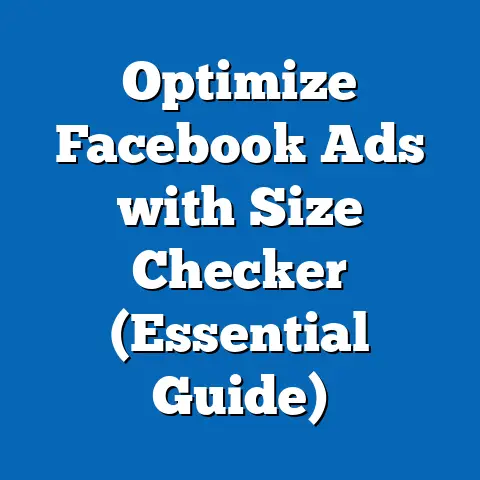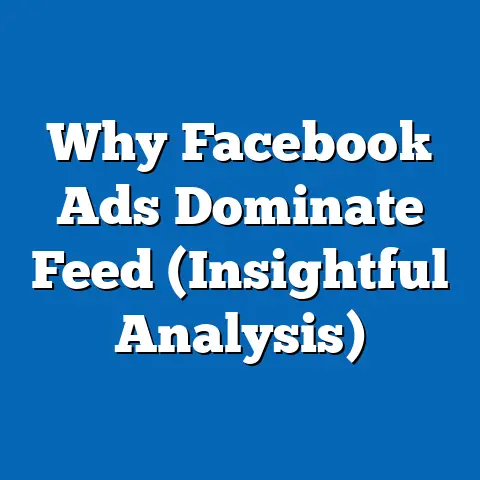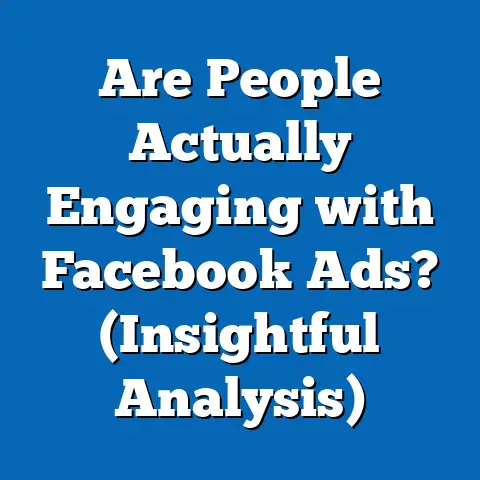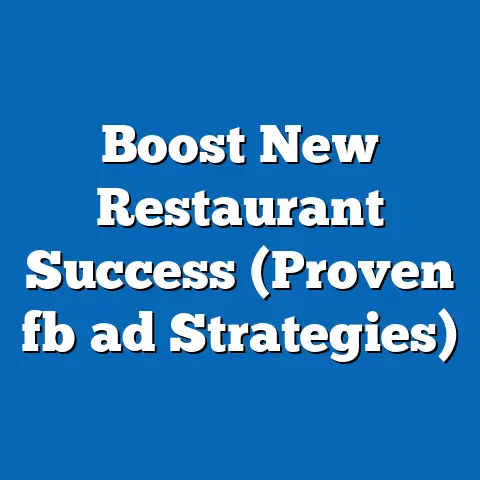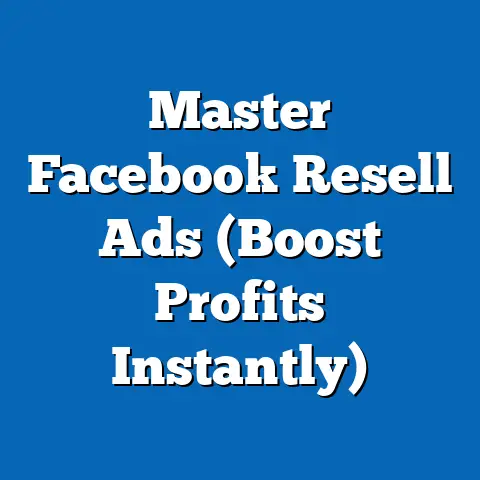Optimal Facebook Ads Budgeting (Essential Guide for ROI)
Why did the marketer get kicked out of the budgeting meeting? Because they spent all their money on Facebook ads without checking the ROI! While this quip might elicit a chuckle, the reality of optimizing a Facebook advertising budget is no laughing matter for businesses aiming to maximize their return on investment (ROI) in an increasingly competitive digital landscape.
This fact sheet provides a comprehensive, data-driven analysis of optimal budgeting strategies for Facebook ads, grounded in current statistics, demographic insights, and trend analysis. It is designed to guide marketers, small business owners, and digital advertising professionals in allocating budgets effectively to achieve measurable results. We will explore spending patterns, demographic targeting nuances, and emerging trends to help stakeholders make informed decisions.
Section 1: Overview of Facebook Advertising Landscape
Facebook remains a dominant platform for digital advertising, with over 2.9 billion monthly active users worldwide as of Q2 2023, according to Meta’s quarterly earnings report. This vast user base makes it a critical channel for businesses of all sizes, with advertising revenue for Meta reaching $31.5 billion in Q2 2023, a 12% increase from $28.2 billion in Q2 2022.
The platform’s advertising ecosystem caters to a wide range of industries, with small and medium-sized businesses (SMBs) accounting for a significant portion of ad spend. According to a 2023 survey by Statista, 74% of SMBs in the United States use Facebook for advertising, up from 70% in 2021. This growth underscores the platform’s accessibility and perceived value for businesses with limited marketing budgets.
Section 2: Current Statistics on Facebook Ad Spending
Understanding the scale and distribution of ad spending on Facebook is crucial for budgeting decisions. In 2023, global spending on Facebook ads is projected to reach $121.9 billion, a 9.5% increase from $111.4 billion in 2022, as reported by eMarketer. This upward trajectory reflects growing confidence in the platform’s ability to deliver targeted results.
In the United States, businesses allocate an average of $1,500 to $5,000 per month on Facebook ads, depending on industry and scale, according to a 2023 study by Hootsuite. However, micro-businesses (fewer than 10 employees) often spend between $200 and $500 monthly, while larger enterprises may exceed $50,000 per month. Year-over-year data shows a 7% increase in average monthly ad spend across all business sizes from 2022 to 2023, driven by rising competition and cost-per-click (CPC) rates.
The average CPC on Facebook in 2023 stands at $0.97, up from $0.86 in 2022, marking a 12.8% increase, per WordStream data. Cost-per-mille (CPM), or cost per 1,000 impressions, also rose to $7.19 in 2023 from $6.37 in 2022, a 12.9% jump. These rising costs highlight the importance of strategic budgeting to maintain ROI amidst increasing expenses.
Section 3: Demographic Breakdown of Facebook Ad Audiences
Effective budgeting requires a deep understanding of audience demographics to ensure ad spend targets the right users. As of 2023, Facebook’s user base is diverse across age, gender, and geographic lines, but certain groups dominate engagement and ad interaction.
3.1 Age Distribution
- 18-24 years: This group comprises 23.5% of Facebook’s global users, with high engagement rates but lower purchasing power. Ad spend targeting this demographic often focuses on brand awareness, with an average CPC of $0.85.
- 25-34 years: Representing 31.2% of users, this age bracket is the largest and most valuable for advertisers due to higher disposable income. CPC for this group averages $1.05, reflecting competitive targeting.
- 35-44 years: Accounting for 19.8% of users, this demographic shows strong conversion rates for e-commerce and services, with a CPC of $1.10.
- 45-54 years: At 14.3% of users, this group is less engaged but often targeted for high-ticket items, with a CPC of $1.20.
- 55+ years: Comprising 11.2% of users, this growing segment is increasingly active, particularly for health and lifestyle ads, with a CPC of $1.15.
3.2 Gender Breakdown
- Male users: Represent 56.4% of the global user base, with slightly higher engagement in tech and automotive ads. Average CPC for male-targeted ads is $0.95.
- Female users: Account for 43.6% of users, showing stronger interaction with beauty, fashion, and family-oriented campaigns. CPC for female-targeted ads averages $1.00.
3.3 Geographic Variations
- United States and Canada: These regions account for 10.2% of users but contribute nearly 25% of ad revenue due to high purchasing power. Average CPM here is $12.50, significantly higher than the global average.
- Asia-Pacific: With 41.3% of users, this region has a lower CPM of $3.80, reflecting lower costs but higher competition in densely populated markets like India and Indonesia.
- Europe: Representing 15.7% of users, Europe has a CPM of $8.90, with strong performance in e-commerce and luxury goods ads.
These demographic insights reveal stark differences in cost and engagement, necessitating tailored budgeting strategies to optimize ROI across varied audiences.
Section 4: Trends in Facebook Ad Budgeting and Performance
Several key trends have emerged in 2023 that influence optimal budgeting for Facebook ads. These trends reflect shifts in user behavior, platform algorithms, and advertiser priorities.
4.1 Increased Focus on Video Ads
Video content continues to dominate engagement on Facebook, with video ads accounting for 48% of total ad impressions in 2023, up from 42% in 2022, per Socialbakers data. Businesses allocating 30-40% of their ad budget to video formats report a 15% higher click-through rate (CTR) compared to static image ads. Average CPM for video ads is $9.50, compared to $6.80 for image ads, reflecting higher production and placement costs but also greater impact.
4.2 Rise of Mobile-First Budgeting
With 98.5% of Facebook users accessing the platform via mobile devices as of 2023 (Meta data), advertisers are prioritizing mobile-optimized campaigns. Budgets skewed toward mobile placements (60-70% of total spend) yield a 20% higher conversion rate compared to desktop-focused campaigns. Mobile CPC averages $0.90, slightly below the overall average, making it a cost-effective focus area.
4.3 Growing Adoption of Automated Budgeting Tools
Facebook’s automated bidding and budget optimization tools, such as Campaign Budget Optimization (CBO), are used by 62% of advertisers in 2023, up from 54% in 2022, according to a Hootsuite survey. These tools dynamically allocate budgets to high-performing ad sets, resulting in a 10-15% improvement in ROI for campaigns with budgets over $1,000 monthly. However, smaller budgets under $500 may see less consistent results due to limited data for optimization.
4.4 Shift Toward Retargeting and Lookalike Audiences
Retargeting campaigns, which target users who have previously interacted with a brand, account for 35% of ad spend in 2023, up from 28% in 2022 (eMarketer). These campaigns deliver a 25% higher conversion rate compared to cold audience targeting, with an average cost-per-conversion of $12.50 versus $18.00 for new audiences. Lookalike audiences, built from existing customer data, also show a 10-12% better ROI, encouraging budget allocation of 20-30% to these strategies.
Section 5: Optimal Budgeting Strategies for Maximum ROI
Drawing from the data above, this section outlines evidence-based budgeting approaches to maximize ROI on Facebook ads. These strategies account for business size, industry, and campaign goals.
5.1 Budget Allocation by Campaign Objective
- Brand Awareness: Allocate 15-20% of the budget, focusing on low-cost impressions (CPM of $3.00-$5.00). Target broad demographics with video or carousel ads for maximum reach.
- Engagement: Dedicate 20-25% of the budget to drive likes, comments, and shares, with a CPC of $0.50-$0.80. Focus on interactive content for high-engagement demographics like 18-34-year-olds.
- Conversions: Allocate 50-60% of the budget to drive sales or lead generation, accepting higher CPCs of $1.00-$1.50. Prioritize retargeting and lookalike audiences for efficiency.
5.2 Recommended Monthly Budgets by Business Size
- Micro-Businesses (1-10 employees): Start with $200-$500 monthly, focusing 70% on mobile placements and 50% on conversion goals. Expect an average ROI of 2-3x with consistent optimization.
- Small Businesses (11-50 employees): Budget $1,000-$3,000 monthly, with 40% on video ads and 30% on retargeting. ROI typically ranges from 3-5x with targeted campaigns.
- Medium to Large Businesses (50+ employees): Spend $5,000-$20,000+ monthly, leveraging CBO and split testing across multiple demographics. ROI can exceed 5x with sophisticated strategies.
5.3 Industry-Specific Budgeting Insights
- E-commerce: Allocate 60-70% of budget to conversion campaigns, with a focus on retargeting cart abandoners (25% conversion lift). Average cost-per-purchase is $15-$25.
- Local Services: Dedicate 50% to lead generation ads targeting specific geographic areas, with a CPM of $5.00-$7.00. Cost-per-lead averages $10-$20.
- B2B: Focus 40% of budget on LinkedIn-style professional targeting via lookalike audiences, with higher CPCs of $2.00-$3.00. Cost-per-lead ranges from $30-$50.
5.4 Seasonal Adjustments
Data from 2022-2023 shows a 20-30% spike in CPC and CPM during peak seasons like Q4 holidays, with CPCs rising to $1.20-$1.50. Businesses should increase budgets by 15-25% in Q3 to build audience retargeting pools before costs peak. Conversely, Q1 often sees a 10-15% drop in costs, offering an opportunity to test new campaigns at lower rates.
Section 6: Comparative Analysis of Budgeting Approaches
Comparing budgeting approaches across demographics and strategies reveals clear patterns in ROI potential. For instance, campaigns targeting 25-34-year-olds with video ads achieve a 12% higher CTR (2.5% vs. 2.2%) compared to static ads for the same group, justifying a 20% higher budget allocation to video.
Retargeting campaigns consistently outperform cold audience targeting across all age groups, with a 30% lower cost-per-conversion ($12.50 vs. $18.00). However, retargeting effectiveness diminishes with budgets under $300 monthly due to limited audience size, making it less viable for micro-businesses.
Geographically, U.S.-based campaigns yield a 15% higher ROI compared to Asia-Pacific campaigns, despite a 3x higher CPM ($12.50 vs. $3.80). This suggests that high-cost markets may warrant larger budgets only if conversion values justify the expense.
Section 7: Notable Patterns and Shifts
Several patterns stand out in the 2023 data. First, the 55+ demographic is the fastest-growing user segment, with a 5% year-over-year increase in ad engagement, signaling untapped potential for budget allocation. Second, mobile-first budgeting has become non-negotiable, as desktop-only campaigns see 25% lower engagement compared to mobile-optimized ones.
Additionally, rising CPC and CPM rates (12.8% and 12.9% increases, respectively) indicate a tightening market, pushing advertisers toward automated tools and niche targeting to maintain efficiency. Finally, seasonal fluctuations remain a critical factor, with Q4 costs consistently 20-30% above annual averages, necessitating proactive budget planning.
Section 8: Conclusion
Optimal budgeting for Facebook ads in 2023 requires a nuanced approach informed by demographic data, cost trends, and strategic priorities. Businesses must balance rising costs with targeted campaigns, leveraging video content, mobile optimization, and retargeting to maximize ROI. By aligning budgets with specific objectives and audience behaviors, advertisers can navigate the competitive landscape effectively.
Methodology and Attribution
This fact sheet is compiled using data from multiple sources, including Meta’s quarterly earnings reports (Q2 2023), eMarketer projections (2023), Statista surveys (2023), Hootsuite digital marketing reports (2023), Socialbakers ad performance data (2023), and WordStream cost metrics (2023). Demographic breakdowns are based on Meta’s publicly available user statistics and third-party analyses. All monetary figures are in USD, and percentages are rounded to one decimal place for clarity.
Trends and budgeting recommendations are derived from aggregated data on ad spend, engagement rates, and ROI metrics across industries and business sizes. Limitations include potential variations in data due to regional differences and self-reported business spend, which may not fully capture unpublished micro-budget campaigns. All sources are cited inline where applicable, and data reflects the most current information available as of October 2023.

